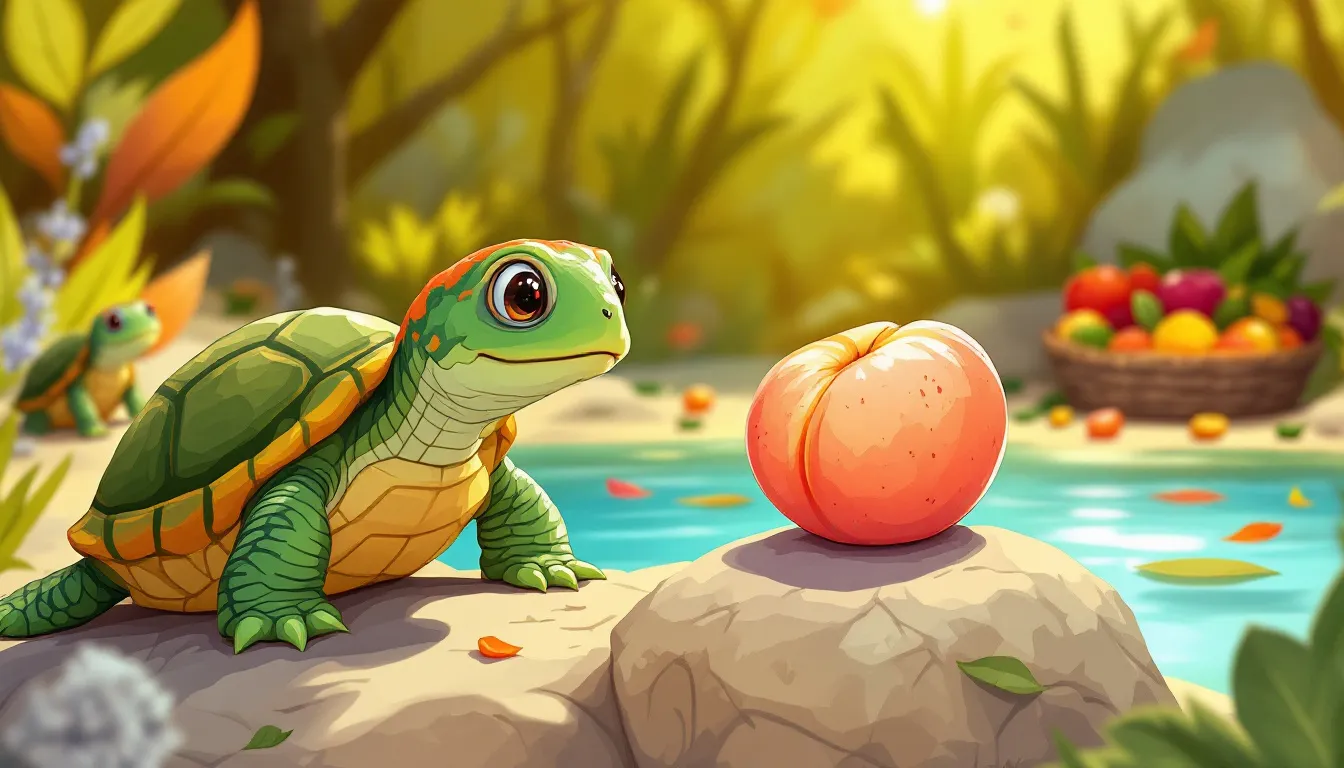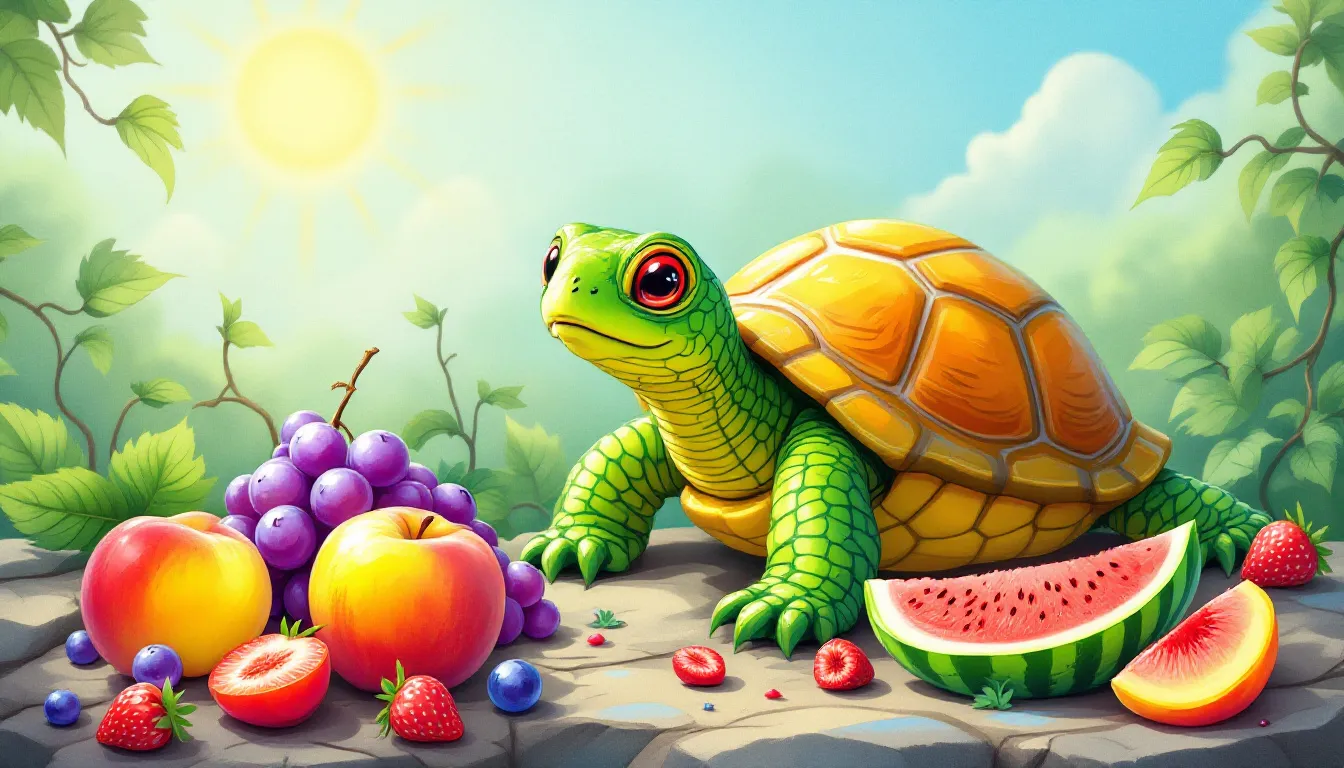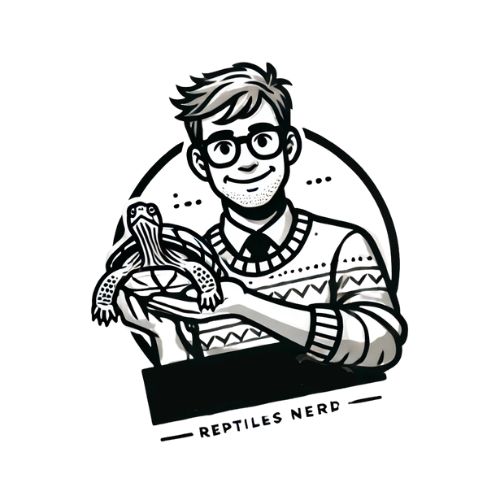Can red-eared sliders eat peaches? Yes, but only occasionally and with some precautions. This article explains why moderation is key, the benefits, potential risks, and how to safely feed peaches to your turtle.
Key Takeaways
- Peaches can be fed to red-eared sliders as an occasional treat, but it’s essential to remove the pit and offer them in moderation to avoid digestive issues.
- Prepare peaches by chopping them into small pieces and feed them in a separate container to monitor intake and maintain water quality.
- A balanced diet for red-eared sliders should primarily consist of leafy greens, vegetables, and protein, with fruits like peaches making up only a small portion.
Are Peaches Safe for Red-Eared Sliders?

The safety of feeding peaches to red-eared sliders is a common concern among pet owners. The good news is that peaches can be offered to red-eared sliders as an occasional treat due to their natural sweetness. However, it’s crucial to remember that moderation is key. While peaches are generally safe, excessive fruit consumption can lead to digestive issues in turtles.
Peaches contain a high level of water, aiding in hydration, especially during warmer months. However, certain precautions are necessary before offering peaches to your pet turtle.
Always remove the pit of the peach to prevent choking hazards before offering it to your red-eared slider. While the peach flesh is safe, overfeeding can cause digestive issues due to its sugar content, so moderation is advised.
In the wild, red-eared sliders have a varied diet and rarely consume fruits like peaches, reinforcing the idea that peaches should only be an occasional treat. Offering a balanced diet that mirrors their natural eating habits is crucial for their health and well-being.
Following these safety tips and understanding the risks will help you make informed decisions about feeding peaches to your red-eared slider. Now, let’s delve into how to properly prepare and introduce peaches to their diet.
How to Feed Peaches to Your Red-Eared Slider

Feeding peaches to your red-eared slider requires a few essential steps. Always ensure the peaches are ripe and free from mold or pesticides to avoid health issues from contaminated fruit.
Chop peaches into small, manageable pieces to make it easier for your red-eared slider to eat and to reduce the risk of choking. The skin can be left on as it provides additional fiber and nutrients beneficial for your slider’s diet.
Feeding them in a separate container helps maintain water quality in the tank and allows you to monitor their food intake, preventing overindulgence.
Introduce peaches gradually into their diet. Start with a small piece and observe their reaction. If they enjoy it without adverse effects, you can offer peaches as an occasional treat. Variety is key in their diet, and peaches should not replace regular food.
Feeding peaches can be a delightful experience if done correctly. Now that you know how to feed them safely, let’s explore portion control and frequency.
Portion Control and Frequency
Portion control and frequency are crucial when feeding peaches to your red-eared slider. Peaches should only make up a small part of their diet due to their high sugar content, which can cause digestive problems and other health issues.
Offer peaches sparingly. Limit the amount to what your turtle can eat within 10-15 minutes to prevent overfeeding and ensure peaches don’t become a significant part of their diet. Fruits should be a minor part of their diet to avoid health issues from excessive sugar intake.
Since fruits are not a natural part of their wild diet, they should be provided in limited amounts. Overfeeding can cause obesity and other health problems, so it’s best to treat peaches as a special treat rather than a regular meal component.
Your red-eared slider’s diet should mainly consist of leafy greens, vegetables, and protein sources like cooked chicken and commercial pellets. This balanced approach ensures they receive all necessary nutrients without excessive sugar. Proper red eared slider care is essential for their health.
Managing portion sizes and frequency allows safe incorporation of peaches into their diet without compromising health. Now, let’s explore the nutritional benefits that peaches can offer to your pet turtle.
Nutritional Value of Peaches for Red-Eared Sliders

Peaches not only make a tasty snack but also offer several nutritional benefits for red-eared sliders. Rich in vitamins A and C, peaches support various bodily functions, including immune system health and vision.
The fiber in peaches aids digestion, keeping your turtle’s digestive system running smoothly. The high water content in peaches provides essential hydration, crucial for proper bodily functions and preventing dehydration.
Peaches contain antioxidants that help reduce oxidative stress, contributing to your pet’s longevity and overall well-being by mitigating cellular damage.
While nutritious, peaches should be part of a balanced diet to enhance the health of red-eared sliders. The nutritional benefits of peaches can be enjoyed without compromising the overall balance required for a healthy turtle.
With an understanding of the nutritional value of peaches, let’s discuss the broader importance of a balanced diet for your red-eared slider.
Importance of a Balanced Diet for Red-Eared Sliders

A well-balanced diet is essential for the health and longevity of red-eared sliders. They require a combination of animal and plant-based foods to thrive. A balanced diet helps prevent health issues like kidney disease resulting from improper feeding practices. Red eared sliders eat a variety of foods to maintain their health.
A variety of foods enriches their diet and provides mental stimulation, essential for their well-being. Leafy greens and certain vegetables should make up a significant portion of their diet, providing essential nutrients and fiber.
Commercial turtle pellets are convenient but should only make up about 25% of the overall diet. While young sliders mainly need animal proteins, introducing dandelion greens early promotes vegetable acceptance as they grow. Dietary variety ensures they receive all necessary nutrients.
Feeding aquatic plants like anacharis and water hyacinth can be beneficial. These plants mimic their natural habitat and provide additional nutrients, making them an excellent dietary addition.
Balancing fruits like peaches with other foods ensures a well-rounded diet that supports their health and happiness. Understanding and implementing these dietary guidelines ensures the best care for your pet turtle and provides the right turtle food.
Summary
In summary, peaches can be a safe and nutritious treat for your red-eared slider when offered in moderation. They provide essential vitamins, fiber, hydration, and antioxidants, which can contribute to your pet’s overall health. However, it’s crucial to maintain portion control and balance peaches with other food sources to prevent health issues related to excessive sugar intake.
A well-balanced diet for red-eared sliders should include a mix of animal and plant-based foods, including leafy greens, vegetables, and commercial pellets. By following these guidelines, you can ensure that your red-eared slider remains healthy, happy, and well-nourished.
Frequently Asked Questions
Can red-eared sliders eat peaches every day?
You definitely shouldn’t feed red-eared sliders peaches every day; their high sugar content makes them more of an occasional treat. Stick to a balanced diet for your turtle for optimal health!
Should I remove the skin of the peach before feeding it to my red-eared slider?
You don’t need to remove the skin of the peach for your red-eared slider; it adds extra fiber and nutrients that are beneficial. So go ahead and let them enjoy the whole fruit!
How much peach can I feed my red-eared slider?
You can feed your red-eared slider as much peach as it can eat in about 10-15 minutes to prevent overfeeding. Just keep an eye on the portion size!
Are there any risks associated with feeding peaches to red-eared sliders?
Absolutely, feeding red-eared sliders too many peaches can cause digestive problems because of their high sugar content. Moderation is key to keeping your pet healthy!
What other fruits can I feed my red-eared slider?
You can feed your red-eared slider berries, melons, and apples, just be sure to give them in moderation. It’s a great way to add variety to their diet!

